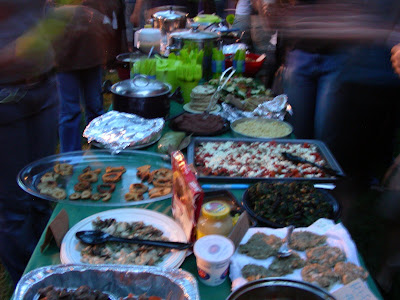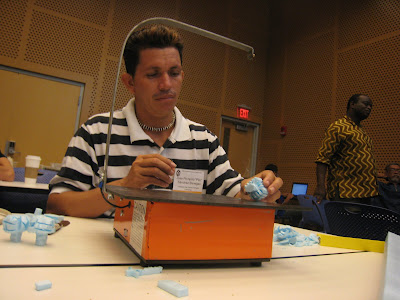One of the concerns expressed about last year's conference by many of the past participants, and by Amy herself, was that teams began to think about the implementation stage of their project far too late. To help solve that problem Amy invited Paul Hudnut, a lecturer in entrepreneurship at Colorado State University, Bainbridge Graduate Institute and Bordeaux Business School. Paul has worked extensively with Envirofit International, a company which develops and disseminates products and services that address major environmental problems in the developing world, and shared his insights with our IDDS participants. He spoke about the crucial need for dissemination of technological ideas and he highlighted it as the difference "between invention and innovation – between creativity and making a difference."
Technological and design innovations on pre-existing products such as solar cookers are all well and good but Paul stressed the importance of designing for dissemination and the specific needs of people living in developing countries. Too often, he said, designers and engineers throughout the world do not focus on these two crucial factors and as such many of the very real needs and problems of the world's poorest people remain unmet and unsolved.
Paul Hudnut speaks about technology and entrepreneurship
He argued that what is needed are business models and business thinking designed into the construction of projects right from the very beginning. He used the example of the 2 stroke retrofit engine kit, designed by Envirofit to help combat the pollution problems, and their knock on effects, caused by a 100 million two and three wheeler vehicles in Southeast Asia. The key concept here is that the buyer begins to make money the day it is installed, similar to the treadle pump system which Paul Polak spoke on, thus providing them with serious incentives to make use of the product. Check out some of the work Envirofit does at http://www.envirofit.org/ and also see Paul Hudnut's blog "What's a Bopreneur?", http://bopreneur.blogspot.com/ , for further information on the ideas touched on so tentatively here.
After the participants had engaged in some entrepreneurship sessions within their groups they were free to return to the experimentation, discussion and research stages of their all important IDDS projects. All of the participants I spoke to in the intervening break period had extremely positive things to say about the Entrepreneurship sessions and were looking forward to applying Paul's basic two step concept, "1)What Sucks? and 2)What are you going to do about it?", to their own particular design problems and projects.
After a day spent working within their teams it was time for the participants to return to the dorms to begin frantic last minute preparations for the much anticipated IDDS 2008 Potluck Dinner. Each participant had been charged with "designing and constructing", in the true IDDS spirit, a dish that represented some aspect of their home culture. I cycled home from IDDS central as fast as I could and was not surprised to find that the usually quite relaxed and docile Burton Conner dorms had turned into a hive of activity. Participants from over twenty countries one and all threw off their inhibitions and unabashedly attempted to steal all the hard won cooking utensils from the organizer's suite. Myself and Tombo were reluctant to begin cooking as we knew that if we turned our backs for even a moment our precious pots and pans would be lost forever!
Despite these blatant and continued attempts at utensil larceny the atmosphere within the dorms was one of great camaraderie, as participants helped each other out with their individual dishes and learned some exciting new recipes along the way! In our kitchen I worked on a dish consisting of that most traditional of Irish crops, the potato, while Tombo worked on a much more tasty and far more interesting Malawian snack food(absolutely delicious). The diverse range of the foods and cooking methods on offer in the dorms was fascinating and the smells wafting from the various rooms set quite a few stomachs rumbling. By far the most innovative cooking method surprisingly from the English contingent, using a power drill to make their world famous scones and cream!
Some "traditional" Irish cooking
A brilliant innovation for whipping cream!
The Zambians cook Nchima together
Once the clock struck 7pm Crossman and John, the organizers of this year's potluck, began making their rounds of the various suites, attempting to usher participants downstairs to help speed things up. Crossman was quite insistent in his remonstrations with those participants lagging behind, simply because he was absolutely starving! We soon had everyone down in the assigned area(just outside the Burton Conner dorms) and were about to start when we realized that the Zambians and the Brazilians were nowhere to be seen! Rumour has it that the Brazilians were late because of an impromptu dance party in their suite and based on what I have seen in the last few weeks, this would not surprise me in the slightest.
Soon though, everyone was finally together and we could begin. A variety of meals and dishes from India, Ireland, Ghana, Zambia, Scotland, England, Tanzania, Brazil, Guatemala and a host of other countries were polished off by the participants in record time. There was even a "traditional" TV dinner cooked by one of the American participants, Derek Lomas. Conversations were sparked between participants, organizers and mentors as they explained the cultural origins and ingredients of their dishes to each other.
Amy gives the hungry participants licence to eat!

Sumit guards his Mango Lassi protectively(it went pretty quickly!)

Charcoal biscuits - surprisingly sweet!

Some of the foods on offer

The potluck dinner table!
Once the food was finished a clean up of similarly gargantuan proportions ensued and a particular mention must be given here to Gustavo Fujiwara, a third year mechanical Engineering student in the University of Sao Paolo, who did more than his fair share of washing up! Overall though, a superb event and probably my personal highlight of the conference so far.
 Siobhan from the Power generation team examining their wheel mechanism
Siobhan from the Power generation team examining their wheel mechanism The ropeway transport system team looking for some cheap materials!
The ropeway transport system team looking for some cheap materials! Dr. David Sokal, from the Breast Milk team, ready for some testing
Dr. David Sokal, from the Breast Milk team, ready for some testing







 One of Carlos' technologies in action
One of Carlos' technologies in action






 Lico and Limbor work on the stabilized soil block mechanism
Lico and Limbor work on the stabilized soil block mechanism






















 Yours truly, playing up to a good old fashioned stereotype
Yours truly, playing up to a good old fashioned stereotype Ugali(Nchima) with Cabbage
Ugali(Nchima) with Cabbage



 Miguel and
Miguel and 


